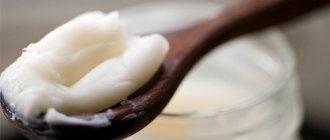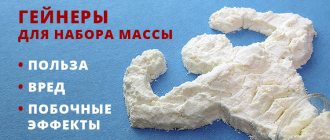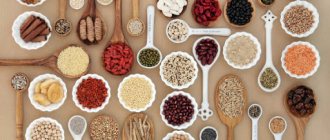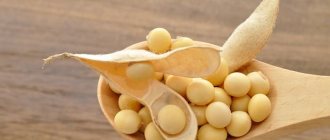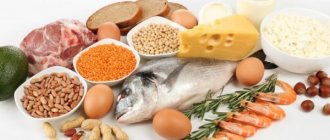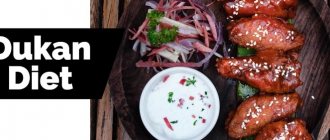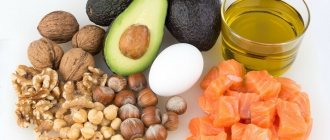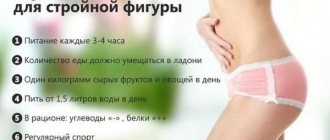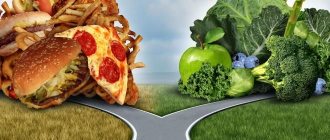In this article we will tell you:
- Types of fats
- Animal and vegetable fats
- Healthy and unhealthy fats
- The body's need for fats
- Basic rules for eating fats
- Recommendations for creating a complete diet
- Balance between Omega-3 and Omega-6 PUFAs
- Sources of Polyunsaturated Omega-3 Fatty Acids
- Benefits of fish oil
- Is cholesterol really that bad?
- Top 10 Foods Rich in Healthy Fats
Fats
- organic compounds containing trihydric alcohol glycerol and free fatty acids. They are one of the main, vital classes of nutrients and perform a number of multidirectional beneficial effects in the body. They are part of cells and tissues, largely giving the latter their specific functions. For example, the myelin sheath of nerves, the main components of which are phospholipids, cholesterol and cerebrosides, ensures isolated conduction of impulses. Fats also form a kind of internal lining of the alveoli - a surfactant, preventing them from collapsing during certain phases of the respiratory cycle.
The energy value of these compounds is more than 2 times higher than that of proteins and carbohydrates: for example, when 1 gram of fat is burned inside the furnaces of our cells, 9.3 kilocalories are released.
Other, no less significant functions are:
- Thermal insulation
— it is this that determines the importance and nature of the deposition of subcutaneous fat.
- Structural
- from biology lessons, many remember the so-called bilipid layer of the membrane - that barrier, the selectively permeable boundary between the internal environment of the cell and the extracellular substance, which, like at the airport at passport control, decides what substances can get in or, on the contrary, get out, and which way - entry is strictly prohibited.
- Regulatory
- the chemical nature of some vitamins (A, D, E, K), as well as hormones (in particular, sex hormones), signaling molecules (both pro-inflammatory and anti-inflammatory) are based on fats - and this significantly expands the entire arsenal of performed functions. For example, prostaglandins, derivatives of arachidonic acid, are important building blocks in the tirelessly building wall of inflammation and are involved in increasing the permeability of vascular walls, their dilation, and the development of edema.
- Shock absorbing
function - they protect internal organs from various types of damage.
Types of fats
Depending on the chemical structure (that is, on the molecules that make up them), all fats can be divided into simple and complex, and within each of these categories, in turn, quite long lists can be compiled with all subspecies and their derivatives.
Nowadays, the division into saturated and unsaturated is very common, depending on the nature of the bond between the hydrocarbon atoms. However, this does not apply to fats, but to fatty acids - one of the two essential components from which lipids are formed.
To saturated fatty acids
(that is, having purely single bonds)
include the following:
propionic, palmitic, stearic. They are rich in animal fats, cocoa butter, butter, palm, coconut and ghee oils.
Unsaturated fatty acids
(in the carbon chains of which double or triple bonds are found)
can be divided into two large groups:
- Monounsaturated fatty acids
(MUFA) contain one double bond.
- Polyunsaturated
(PUFA) – two or more. Perhaps their most striking representatives, and now especially popular among the general population, are Omega-3 and Omega-6.
Omega-3 PUFAs include eicosapentaenoic acid (EPA) and docosahexaenoic acid (DHA), which come directly into the body or are formed from essential (that is, not able to be synthesized within our body) alpha-linolenic acid. They are involved in various processes in our body - their function is not limited to just an anti-inflammatory role.
DHA greatly influences both the development of the nervous system, its differentiation at an early age, and cognitive abilities in adults. Numerous studies show that its lack in the diet leads to impaired memorization and, as a result, learning, deterioration of concentration and attention. So, this organic compound is responsible for the growth of neurons.
In addition, it is very effectively used in the treatment of depression, especially postpartum. It also inhibits the production of pro-inflammatory signaling molecules (such as, say, tumor necrosis factor and interleukin-6). Docosahexaenoic acid is also involved in visual function - its concentration in the photoreceptors of the retina is very impressive.
Study
: Long-chain polyunsaturated fatty acids and their role in baby nutrition
Eicosapentaenoic acid is actively used in the treatment of type 2 diabetes mellitus: it increases the sensitivity of receptors to the protein hormone insulin, thereby helping glucose get from the bloodstream into the cell. It promotes the production of adiponectin by adipose tissue, a hormone that regulates energy metabolism and also has a pronounced pro-inflammatory effect. EPA, as new studies have shown, prevents the development of coronary heart disease in patients with elevated plasma cholesterol levels and, having a nephroprotective effect, reduces the risk of Alzheimer's disease.
Study
: Eicosapentaenoic Acid (EPA) Modulates Glucose Metabolism by Targeting AMP-Activated Protein Kinase (AMPK) Pathway
Beneficial features
Saturated fats in healthy foods are the main source of energy; they help activate the synthesis of hormones in the body and improve its reproductive function.
Saturated fats improve the absorption of vitamin A and also participate in the synthesis of vitamin D.
If a person leads an active lifestyle: works physically or is an athlete, he needs saturated fats to constantly maintain energy and strength at the proper level. By exposing your body to increased stress, you need to replenish it with missing vegetable fats, which are broken down along with vitamins during physical activity.
Animal fats are useful for those categories of people whose profession is associated with increased mental stress, for example, teachers, doctors, drivers.
Regular inclusion of butter or ghee in the list of foods consumed helps protect the nervous system from exhaustion, making it healthier. With a balanced diet, the diet must include saturated fats, excluding trans fats.
Adding vegetable and animal fats to your daily menu helps support your immune system. Saturated fats must be supplied to the body in sufficient quantities, which reduces its susceptibility to infectious diseases. As a result, the function of leukocytes in the blood, associated with the identification and destruction of dangerous bacteria, viruses and fungi, is normalized.
Products of animal and plant origin reduce cholesterol in the blood. They are useful for improving skin, hair and nails, and ensure the production of hormones in the body, including testosterone, which is important for active people.
Saturated fats should be regularly present in baby's diet, which will allow the growing body to well absorb calcium, which strengthens bones. Saturated fats, consumed according to the daily norm, prevent heart attacks and strokes, and ensure the prevention of arthritis and arthrosis.
These substances can slow down the process of carbohydrate absorption, which prevents sudden surges in blood sugar and prevents the development of diabetes. Products containing them should be included in the diet of older people, since over time their bones become more fragile.
Animal and vegetable fats
In many ways, the chemical structure of fats depends on their origin: plant or animal. This determines, as a rule, their consistency and the nature of the bonds (saturated or unsaturated) in the carbon chain. In general, a rational, healthy diet, according to experts, includes both sources.
The variety of vegetable fats is truly impressive: many cereals, nuts, seeds and even vegetables contain them. Oils are produced from seeds, fruits and seeds: sunflower, olive, rapeseed, flaxseed, hemp, grape, cedar and many others. There are several ways to obtain them:
- Pressing
- this technology is more gentle, but is considered less effective: the cake remaining after squeezing contains a large percentage of fat.
- Extraction method
. At the same time, the organic solvents used in the process help to isolate almost all healthy fats from the raw materials.
The food and processing industries use raw materials of various origins (mainly bones and adipose tissue) to produce animal fats, containing large quantities of saturated fatty acids: stearic and palmitic.
This type of organic compound usually enters the human body in the following products:
- Meat and offal
.
- Fatty fish
- An excellent source of omega-3 and fat-soluble vitamins. However, it is worth considering that the absorption of the latter is possible only if there is an adequate outflow of bile, which acts not only as an emulsifier, but also activates pancreatic enzymes.
- Chicken eggs
- an excellent source of fats and protein, as well as choline (in the body it is included in the synthesis of one of the main neurotransmitters - acetylcholine), vitamin E and biotin.
- Milk, cottage cheese, cheese, sour cream, cream
(fat content up to 30%)
, butter and ghee GHI
.
Despite the wide range of beneficial effects that fats have, one should not forget about their fairly high calorie content. Thus, weight loss may be at significant risk if, say, you pour olive oil on your salad to your heart's content. Healthy? Undoubtedly! But only under the condition of sufficient physical activity and within the required caloric intake that satisfies the needs of your body.
Harm and benefit
In a simplified sense, fat is the main source of energy for the body (80% of human energy reserves). Vegetable oil contains various acids, phytosterols, and phospholipids, which are absolutely important for normal metabolism. Nutritionists strongly recommend completely abandoning solid and animal fats, because vegetable oil has more beneficial properties:
- polyunsaturated acids omega-6 and omega-3 are not produced by the human body, but are vital for health (prevent blood clots and increased blood pressure);
- vegetable oil stimulates tissue regeneration;
- natural first cold-pressed oils - suppliers of large amounts of vitamin E, which has a positive effect on the condition of the skin;
- vegetable fats are minimally involved in the formation of bad cholesterol, which provokes atherosclerosis;
- metabolic processes are accelerated;
- blood composition normalizes;
- proper nutrition, balancing the vegetable and meat components in the diet, promotes weight loss;
- the immune system is strengthened;
- a strong cell membrane is formed;
- heart function is normalized;
- the strength and elasticity of blood vessels increases;
- retinol and similar substances protect the body from radiation exposure, reduce the risk of cancer, diabetes, and activate protein synthesis.
It is impossible to unambiguously determine the harmfulness of fats, since the negative effect directly depends on the amount consumed and the method of processing the oil. Such a product can also be harmful if you use it exclusively, completely abandoning animal lard. A cheap product of plant origin, with fanatical adherence to diets, provokes serious consequences:
- an excess of vegetable fats without a balance with animals can cause infertility in women;
- after severe heat treatment, oxidized polyunsaturated fats provoke thinning of the artery walls;
- oxidized fats are not absorbed by the body, but settle on the walls of blood vessels, which in the future provokes heart pathologies, cancer, obesity, and diseases of the gastrointestinal tract.
- Delicious eggplant snacks in adjika for the winter without sterilization
- Crucian carp in the oven - step-by-step recipes with photos. How to cook baked crucian carp whole or stuffed
- Removing moles - methods and indications with photos
Healthy and unhealthy fats
Just a few decades ago, low-fat diets were at the peak of popularity: they were promoted as perhaps the only and most reliable way to prevent coronary heart disease, heart attack and stroke.
However, a sharp decrease in the content of fats, which act as the most saturated foods (as many as 9 kilocalories compared to 4, which gives, for example, 1 gram of protein), led to a rapid increase in the amount of carbohydrates in the composition of manufactured products - the era of diabetes and obesity has arrived.
So, given the undeniable importance of this class of compounds, completely eliminating or reducing its portion allocated on the plate is not the most rational idea, which, at a minimum, will lead to disruptions of the menstrual cycle and the functioning of the endocrine system as a whole.
Conventionally, all fats can be divided into “healthy” and “not so healthy” - although the classification, we repeat, is very subjective.
The first group includes sources of omega-3 polyunsaturated fatty acids
- their anti-inflammatory effect and modulating effects on the cardiovascular system have been proven in dozens, if not hundreds, of studies.
As was previously said, in the realities of the modern world with its very diverse, but very often far from being as correct as we would like, diet, it is necessary to monitor the optimal ratio between omega-3 and omega-6 fatty acids: the latter act as complete antagonists , involved in many pathological processes of various localizations (it is difficult to name a mechanism in which eicosanoids - derivatives of arachidonic acid) would not be involved. In particular, the same prostaglandins largely imitate the action of histamine, increasing the permeability of the vascular wall (and, as a result, promoting the release of plasma with substances dissolved in it into the tissue - edema develops), leading to spasm of the muscle cells of the intestine, bronchi and uterus.
The second group includes saturated fats and trans fats.
We recommend reducing your consumption of butter, cheese, margarine and fatty meats (beef, lamb, pork), as well as foods high in palm and coconut oils - chocolate, confectionery and fast food.
How to regulate the intake of fat in the body?
Fat-containing foods should be consumed within normal limits. Their excess leads to a set of extra pounds, while their deficiency leads to health problems.
Foods high in fat
Table of foods with maximum fat content:
| Product name | Fat content (per 100 g of product) |
| Palm oil | 93,7 |
| Dried coconut | 57,2 |
| Butter | 51,4 |
| Beef | 52,3 |
| Chocolate | 32,4 |
| Sardine | 29,9 |
| Hard cheese | 24,6 |
These products are consumed in limited quantities.
Low fat foods
Low-fat foods include:
- Skinless chicken breast and veal. They contain a lot of protein and are often included in the diet menu.
- Boiled or steamed fish. Lenten varieties: cod, flounder, pollock, hake.
- Low-fat dairy products: yogurt, milk, cottage cheese, sour cream.
- Vegetables cooked without adding oil.
- Legumes.
This food is great for a diet because it contains few calories.
The body's need for fats
Creating a balanced diet
- This is a purely individual process, which should be carried out by a nutrition specialist, taking into account age, gender, place of residence and degree of physical activity. It is necessary to take into account the following basic relationships:
- Fats should account for no more than 30% of the total calories in the average person's daily diet. Northerners, due to more severe climatic conditions, require about 40%, and residents of southern regions can reduce it to 27-28%.
- If determined in grams, then normally it will be from 1 to 1.5 g/kg of body weight - in other words, 100 grams of fat per day is enough for an adult.
- Vegetable fats should account for 30%, animal fats - 70%.
- Not all fatty acids are essential, which means the body must obtain them from the outside, from food. In addition, we have already said that, say, the process of formation of omega-3 from raw materials supplied with food (in the form of alpha-linolenic acid) proceeds quite slowly - it is more rational to fill the need for them with ready-made forms contained in fatty fish and additives.
- In older people, due to inhibition of metabolic reactions, the proportion of fat in the daily diet should not exceed 25%.
The American Heart Association makes the following recommendations:
The daily diet of a healthy person should contain no more than 30% fats, of which saturated fats make up ≤ 7-10% of the total caloric intake per day, polyunsaturated fats - ≤ 10%, monounsaturated fats - ≤ 15%, cholesterol - < 300 mg/day.
Features of fat absorption
Digestion of fats begins in the small intestine - here, lipases activated by bile entering the duodenum break them down into their component molecules: fatty acids and glycerol. It is interesting that both the oral cavity and the stomach contain this enzyme - but in adults it does not play any practical significance: in particular due to the acidic environment (in the second case) and the lack of an emulsifier, which is bile. It breaks large drops into small ones, thereby making the process much easier and much more efficient.
So, during the digestion process, large triglyceride molecules are broken down into their constituent components - glycerol, fatty acids, cholesterol and monoacylglycerols are formed. The first is directly absorbed into the blood, the rest are included in the so-called micelles, in which they are further transported to cell organelles.
As for bile acids, they are usually absorbed in the ileum - the final section of the small intestine - and return back to the liver - this is the mechanism of enterohepatic circulation.
In the absence of damage to the intestinal mucosa, patients with a difficult process of bile formation can be considered, after preliminary consultation with a gastroenterologist, taking pharmacological drugs - in particular those containing animal bile (“Cholenzim” and “Allohol”).
Possible complications
Vegetable fats, the list of products of which are increasingly ignored by those who prefer fast food, ensure normal absorption of animal fats by the body. The number of people who feel the need for a quick meal is increasing every year.
They have the greatest preference for foods containing saturated fats, but their poor absorption by the body leads to a lack of lipids. For this reason, deviations in brain activity occur, in the process of cell formation of which saturated fats play an important role.
The consequences of poor nutrition, in which foods containing animal fats are included in the daily diet in insufficient quantities, are a deterioration in heart function. Normal functioning of the circulatory system is possible only with the regular intake of lauric and steoric acid into the body.
Saturated fats are rich in these substances, so their lack causes cardiovascular diseases and atherosclerosis. If saturated fats are not supplied to the human body in sufficient quantities along with food, this can cause disruption of the respiratory system.
With a lack of these fats, along with cholesterol, the process of testosterone production, which is necessary for vigorous activity, is inhibited. The risk of respiratory diseases increases. Analyzing the list of food products containing saturated and vegetable fats, we can conclude that they are always present on the menu.
For their normal absorption by the body, it is important to observe the daily intake of these products, since the benefits or harm from them are determined by the calorie content of the daily diet. Any diet involves the inclusion of fatty foods in the menu, since they provide energy value for the human body.
Basic rules for eating fats
- Maintain the amount of fat taking into account your body weight - on average, this is 40-50 grams per day (with a low-carbohydrate diet - up to 60-70 g).
- The ideal ratio of saturated to unsaturated fats is 1:1, and this is what you should strive for when consuming omega-3 and omega-6 polyunsaturated fatty acids.
- Include lecithin in your diet on a regular basis - and give preference to sunflower lecithin rather than soy lecithin.
- Take fat-soluble vitamins A, E, D in courses - but only taking into account previously passed laboratory tests and in small concentrations: remember that they are capable of accumulation in the liver.
- Avoid refined oils and products with trans fats - in particular, margarine: they will not bring any benefit, but they will cause a lot of unpleasant consequences.
We recommend
“Iron deficiency in women: severe consequences and treatment regimen” Read more
- Store vegetable oils correctly: in dark glass jars and away from the stove.
- For frying, use GHI ghee - its delicate creamy flavor will add an incredible taste to the dish; add vegetable oils exclusively to salads.
Recommendations for creating a complete diet
- Hearty breakfast
– from 7:00 to 10:00. If you do not have adrenal fatigue and are prone to hypoglycemia, you can move your first meal closer to noon and thus combine it with lunch.
The ideal formula, following which, you will remember the feeling of hunger no earlier than after 4-5 hours:
- Fats up to 60%.
- Protein 20-40%.
- Carbohydrates 20%.
- Full lunch
– from 12:00 to 14:00. Try to adhere to the following ratio:
- Fats - 15%.
- Protein - 25%.
- Fiber (greens and vegetables) - up to 60%.
- Mostly plant-based dinner
5:00 pm to 6:00 pm is the optimal time to do a relatively easy version of intermittent fasting. Approximate formula:
- Fats up to 15%.
- Carbohydrates up to 75%.
- Protein up to 15%.
Good sources of fat include: avocados, coconut yogurt with paleo granola, olives, keto coffee (with a pat of coconut oil or GHI added), nut milk, full-fat aged cheeses, pine nuts and walnuts, pumpkin seeds, seeds chia, almonds, pistachios, pecans, flax, cashews, cod liver, keto almond flour bread, tahini.
You can get protein from fatty fish, shrimp, scallops, squid, eggs, poultry, vegetable protein, tofu and chickpeas.
Breakfast carbohydrates: quinoa, millet, buckwheat, gluten-free bread, brown rice, amaranth, kale, corn, spinach, arugula, bok choy, chard, watercress, romaine, strawberries, blueberries, blueberries, mango, cherries, pineapple, raspberries , blackberries, goji, pumpkin, carrots, tomatoes, radishes, broccoli, cauliflower, Brussels sprouts.
Bake fish, prepare grilled vegetables and puree pumpkin, cauliflower or broccoli as a side dish. Lamb pilaf, rabbit or poultry - experiment and find new combinations!
A large bowl of vegetable salad with probiotic dressing is ideal - 3-4 types of vegetables: boiled, baked, fermented, raw. You can add one or two flax breads with hummus or tahini - the food should be light and not burdensome.
Balance between Omega-3 and Omega-6 PUFAs
Both the precursor of Omega-3 polyunsaturated fatty acids (alpha-linolenic acid) and Omega-6 (linoleic acid) are essential - that is, their formation inside our body is simply impossible. They come from outside - along with food. The first is found in specific organelles (chloroplasts) of leafy vegetables, as well as in rapeseed, chia, and walnuts; the second is in the seeds of most plants, with the exception of coconut, as well as cocoa and palm trees.
By the way, an interesting fact: the active accumulation of omega-3 PUFAs is noted by the 3rd semester: all because their role in the final formation and differentiation of cells of the nervous system, as previously said, is enormous and undeniable. That is why it is recommended for premature and prematurely born children to include a mixture containing these organic substances in their diet.
In most mammals, including humans, DHA is concentrated in the cerebral cortex, but the retina and testes are also rich in it.
In our body, further stages of biotransformation of alpha-linolenic acid with the subsequent formation of EPA and DHA are possible, but they proceed rather slowly and largely depend on the activity of the FADS1 and FADS2 genes. Fatty fish varieties are rich in these acids.
We recommend
“Omega-3 products: the benefits of polyunsaturated fatty acids” Read more
Interestingly, omega-3 and omega-6 compete with each other for desaturation enzymes (catalyzing the conversion of single bonds between carbon atoms into double ones) - and, oddly enough, both types prefer alpha-linolenic acid, from which they are subsequently formed eicosapentaenoic and docosahexaenoic. However, the high intake of linoleic acid, a precursor to omega-6, found in the typical Western diet, as well as trans fats, interfere with these alpha-linolenic acid conversions.
And if the numerous effects of omega-3 PUFAs are generally beneficial, then omega-6 act as complete antagonists with pronounced pro-inflammatory properties.
Scientists suggest that a significant contribution to the evolution of man as a species was played by his diet - and not least the ratio between polyunsaturated fatty acids. And if in our distant ancestors it was approximately 1:1, now in the modern Western diet the consumption of omega-6 is on average 20 times higher than omega-3. In addition, changes in agriculture, as well as changes in animal feed, also affected this. In addition, scientists note that fish raised naturally in the ocean, rivers and lakes contain eight times more omega-3s than aquaculture.
Omega-6 fatty acids (in particular, arachidonic acid) form inflammatory mediators - prostaglandins, leukotrienes, thromboxanes and other biologically active substances that stimulate thrombus formation. So, an imbalance between their consumption, at a minimum, leads directly to atherosclerosis, impaired carbohydrate metabolism and obesity.
It is surprising that from the point of view of chemical structure the difference lies only in the localization of the double bond, but how diametrically opposed the effects of polyunsaturated acids are.
Study
: An Increase in the Omega-6/Omega-3 Fatty Acid Ratio Increases the Risk for Obesity
Sources of Polyunsaturated Omega-3 Fatty Acids
In nature, Omega 3 is synthesized by diatom algae that grow in clean, cold waters: in streams (even fresh water) and oceans at considerable depth.
In addition, emphasis should be placed on wild plants: they, unlike crops grown in greenhouses, contain the optimal ratio between omega-3 and omega-6 fatty acids. For example, purslane contains eight times more alpha-linolenic acid than red lettuce, lettuce and mustard.
Stick to home-grown and animal-based foods: for example, free-range egg yolks have an omega-6:omega-3 ratio of 1.3, and USDA laying hen eggs have a USDA ratio of 19.9.
The International Fatty Acid and Lipid Society recommends that adults consume at least 500 mg of EPA+DHA daily. You may consider adding fish oil-based dietary supplements to your diet - however, taking into account all of the above, select not only the correct dosages, but also the necessary ratio between DHA and EPA (for example, in childhood, the first should prevail over the second).
We strongly advise you to limit the consumption of sunflower, corn and other vegetable oils, fast food, semi-finished products, fried dishes.
Categories of vegetable fats
Based on the structure of triglyceride molecules, lipid categories are distinguished:
- Unsaturated ones bring the greatest benefits: they improve vision, texture and appearance of the skin, have an anti-inflammatory effect, and prevent the formation of plaques in large vessels. It is to provide them that oils and seeds should be included in the diet. Among animal products, they are found in marine fish.
- Saturated foods increase the load on the heart and add kilograms. Lard and butter are rich in them, and in any vegetable raw material the percentage of such fats is small.
- Trans fats are produced artificially through the hydrogenation of conventional oils. They have a solid texture and are used in industry to reduce the cost of production as a substitute for expensive animal fats (margarines, dairy products) and vegetable fats (a substitute for cocoa butter in the production of confectionery bars, icing for chocolates). They bring only harm to the body. Research shows that their effects are similar to those of high consumption of saturated fat. They contribute to the development of atherosclerosis and heart disease. It is important to read the ingredients on product labels and avoid purchasing if you see the words “cocoa butter substitute” or “palm oil.”
According to the production method, hot and cold pressed oils are distinguished. With the second method, more substances important for health are retained in the oil. It is recommended to buy only unrefined oils.
Benefits of fish oil
Fish fat
- An excellent source of omega-3 polyunsaturated fatty acids. Their effects on preventing and/or improving cardiovascular disease have been studied for many years. In particular, pronounced antiplatelet activity, a significant decrease in the formation of very low density lipoproteins (VLDL), and a decrease in the concentration of certain markers of oxidative stress were noted. They were also used in the treatment of osteoarthritis: due to their ability to suppress pain in the knee joints.
One of the most important and significant benefits of using fish oil supplements is the virtual absence of any kind of side effects.
The results of recent trials indicate the effectiveness of the use of omega-3 fatty acids in the treatment of depression: this is achieved, according to the authors, both by the pro-inflammatory effect of these organic compounds and by their direct effect on the properties of cell membranes.
Study
: Fish oil and depression: The skinny on fats
Interestingly, a two-week diet rich in EPA and DHA caused a significant increase in the expression of Ucp1 in rats - uncoupling protein 1, present in the inner membrane of our energy stations, mitochondria, and uncouples the processes of oxidation and phosphorylation - energy is dissipated as heat rather than going to waste. ATP formation. In simple words, the process of heat generation starts.
Study
: Fish oil as a potential activator of brown and beige fat thermogenesis
What is fat?
These organic compounds are substances that, together with proteins and carbohydrates, form the basis of the human diet. They must enter the body, because they perform their functions in it. Complete exclusion of fat-containing foods from the diet leads to deterioration of health and the development of certain diseases.
Lipids are compounds of fatty acids with glycerol esters.
These structures do not dissolve in water and are found in living cells. Entering the body in excess quantities, they are deposited as fat reserves.
Is cholesterol really that bad?
More recently, it was accused of all human sins, considering it the primary cause of almost all pathologies of the cardiovascular system. A new trend for low-fat products has emerged - every second manufacturer loudly announced this in bold letters on the packaging. True, the carbohydrate content in them also increased sharply - however, so far few have paid attention to this.
We recommend
“What is dietetics and nutritionology: what are their differences” Read more
Whether we like it or not, we need cholesterol just like, say, proteins: even based on the simple logic that otherwise it would not be synthesized inside our body. So, it is nothing more than a raw material for the formation of sex hormones, adrenal hormones and, of course, vitamin D.
Low-fat diets always lead to disruptions in the menstrual cycle: what are its conductors formed from if all sources of income are either strictly limited or completely excluded?
Cholesterol is part of cell membranes, participates in the construction of the myelin sheath, which ensures isolated propagation of impulses along nerve fibers; its significant concentrations are observed in the white matter of the brain.
Top 10 Foods Rich in Healthy Fats
- Walnuts
- an excellent source of omega-3 fatty acids (particularly alpha-linoleic acid). According to studies, their use helps reduce “bad” cholesterol - that is, what is contained in atherogenic low-density lipoproteins - and cleanses blood vessels.
- A portion black olives
contains about 15 g of fat. In addition, they contain concentrated hydroxytyrosol, which has an anticancer effect and has a positive effect on the preservation of bone tissue.
It is enough to eat from 5 to 10 pieces per day, depending on their size
- Fatty fish
: salmon, trout, mackerel, sardines. This is another excellent source of omega-3s and a simple, effective way to prevent cardiovascular disease. It is recommended to eat dishes based on them at least two to three times a week.
- Avocado
- on average, the fat content in it is close to 20-25 grams. This incredibly tasty and versatile product can replace mayonnaise on your sandwich, butter on toast, or sour cream when baking potatoes. Mash its pulp with a fork, add salt, pepper, aromatic herbs and finely chopped tomatoes - a light and satisfying snack is ready.
- Good black chocolate
- fatty, no added sugar and with a rich cocoa aroma. We recommend considering products from brands that adhere to the concept of the keto diet and/or LCHF (low carb, high fat) - they have a minimum of carbohydrates, which are usually deposited in extra centimeters on the waist, and erythritol is used as a sweetener.
In addition, it is a good source of plant antioxidants, vitamins (A, B and E), as well as many minerals: in particular, calcium, iron, potassium, magnesium.
- Natural yogurt
(provided there is no intolerance to milk sugar and/or casein)
-
contains beneficial bacteria.Choose Greek - you can always prepare the filling yourself, using fresh or frozen berries, pieces of fruit, or almond flakes. You can also consider using plant-based yogurt - give preference to those made with almond rather than soy milk.
- Hard, aged cheese
- provides the body - in particular, bone tissue - with calcium in sufficient quantities. In addition, it, like meat and eggs, is a source of complete protein.
- Cod liver
- another excellent product rich in polyunsaturated fatty acids. Add a couple of its tender pieces to your breakfast - and we assure you that the feeling of hunger will not soon make itself felt.
We recommend
“Age-related dietary habits: what you should pay attention to” Read more
However, it is also necessary to remember that very often improper preparation and lack of sanitary control lead to such unpleasant consequences as helminthic infestation. That is why, before eating, always try to carefully examine pieces of meat for unexpected friends.
- GHI oil
- not just another fashion trend, but a truly indispensable product in the kitchen, which, by the way, is perfect for people with lactase deficiency.
- Lean meats
The choice of meat, as well as the method of preparing it, must be approached very carefully and with all the responsibility that you are capable of.
Lean beef, for example, contains a lot of protein, vitamins and minerals - in particular, iron and zinc, which are necessary for the functioning of most enzyme systems.
Is it possible to eat foods high in fat?
We are accustomed to being wary of fats and carbohydrates. As soon as the need arises to lose weight or get in shape, we certainly give up fats or carbohydrates (or two components at once). Why is this bad and completely unreasonable?
According to the research “The effects of a low-carbohydrate diet on appetite: A randomized controlled trial”, for weight loss it will be quite enough to reduce the level of carbohydrate intake, but not give up on them!. Thanks to periodic changes in KBJU, due to carbohydrates, it will be possible to lose/gain weight and reduce the risk of developing heart and vascular diseases. A complete rejection of fat will cause hormonal and energy disruptions, after which you can easily end up in a hospital ward.
Is there a connection between fats and weight gain?
The fear of extra pounds is based on the following fact: 1 gram of fat is 2 times more caloric than 1 gram of carbohydrates or proteins. But many people forget that the human body is a carefully thought-out machine in which complex biochemical processes occur every second. Simple mathematics does not always apply to the process of forming and burning fat. Why?
Calories that come from different foods (protein, carbohydrates, fat) have different effects on the body. This uneven impact extends to metabolic processes, hormonal levels, the immune system, brain function, internal microflora and even genes. Nutritionists have conducted many studies and proven: natural healthy weight loss is possible only with normal fat consumption and a reduced concentration of carbohydrates. The opposite statement is a myth on which large companies and inept nutritionists make money.
What kind of fats can you eat?
Vegetable fat is considered the healthiest and safest. It is generated for humans by nature itself and enters the body almost in its original form. The first thing you need to pay attention to is nuts and oils. PROMED came to the defense of unsaturated vegetable fats with the publication “Primary Prevention of Cardiovascular Disease with a Mediterranean Diet.” Scientists say that oils from walnuts, almonds, olives and sunflowers can:
- regulate blood cholesterol levels;
- prevent diseases of the heart and blood vessels, improve their functionality;
- enrich the body with vital vitamins and nutrients;
- promote natural weight loss;
- have a beneficial effect on female and male hormonal levels;
- improve external data - the condition of hair, skin, nails.
Also, nutritionists advocate adding various seeds (pumpkin, flax, hemp and others) to the diet. They protect cells from oxidative processes, thereby maintaining their integrity and functionality. Also, healthy seeds regulate blood glucose levels and protect the body from diabetes.
Remember: there is a huge difference between a handful of pecans and deep-fried ice cream.
High-quality oils are found only in products of plant origin. It is desirable that the product undergoes minimal processing or enters the body in its pure form. Unprocessed plant products retain their integrity and have a beneficial effect on the body. Plant foods containing healthy fat
| Nuts | Oils | Seeds |
| Peanut | Ghee | Chia |
| Hazelnut | Olive | Linen |
| Pistachios | Cocoa | Pumpkin |
| Almond | Hemp | Cedar |
| Walnut | Coconut | Sunflower |
